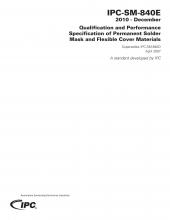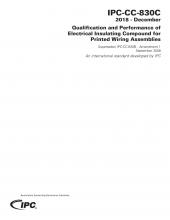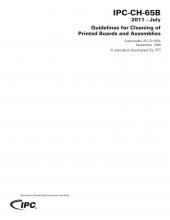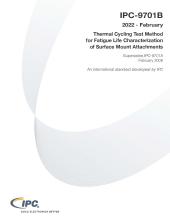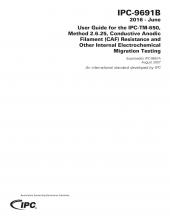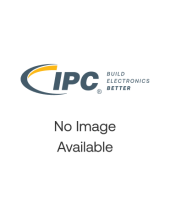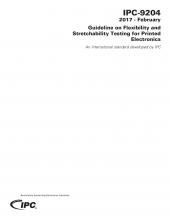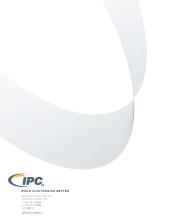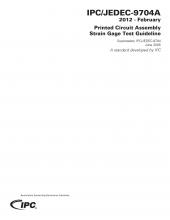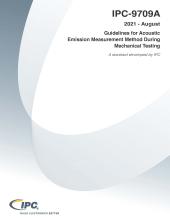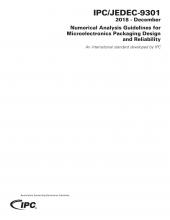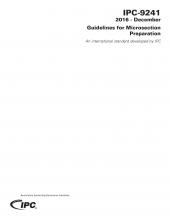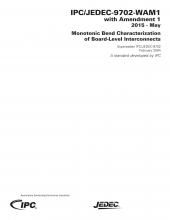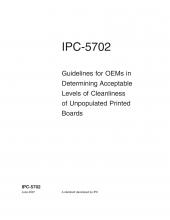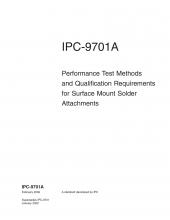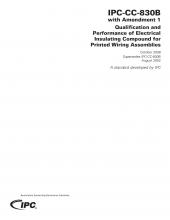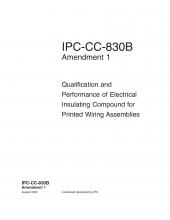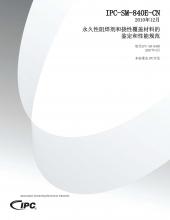Products
Establishes the requirements for the evaluation of liquid and dry film solder mask material and for the determination of the acceptability of use on a standard printed board system. IPC-SM-840 provides two classes of requirements, T and H, to reflect functional performance requirements and testing severity based on industry/end use requirements. Coverage is given to adhesion, material qualification...
The IPC-CC-830C standard establishes qualification and conformance requirements for electrical insulating compounds (conformal coatings). It has been designed and constructed with the intent of obtaining maximum confidence in the materials with minimum test redundancy. The IPC-CC-830C standard covers: The qualification and qualification retention of the conformal coating material (Table 3-1...
This document includes lead free, no-clean, and environmental friendly chemistries. This is a collection of information on electronic board and assembly cleaning in a single location. This major revision explains the relationship between materials, processes, and contaminants in fabrication and assembly operations. It also addresses cleanliness assessment and process control in relation to...
The IPC-9701B standard establishes a thermal cycling test method to characterize the fatigue lifetimes of surface mount solder attachments of electronic assemblies. The surface mount devices may be solder-attached to rigid, flexible or rigid-flex printed boards. The characterization results can be used to predict the field lifetime of solder attachments for the use environments and conditions of...
This document is the product of the IPC Electrochemical Migration (ECM) Task Group. It was drafted to provide guidance regarding implementation of the User Guide for the IPC-TM-650, Method 2.6.25, Conductive Anodic Filament (CAF) Resistance and Other Internal Electrochemical Migration Testing to evaluate the effects of mechanical stress, laminate material fracturing, ionic contamination, moisture...
While there are a variety of industry test vehicles for the examination of material compatibility, the IPC-B-52 test board was created to meet the needs for testing both ion chromatograph and surface insulation resistance (SIR) which would be more representative of the manufacturing materials and processes. IPC-9203A standard addresses the IPC-B-52 test vehicle, which can be used to evaluate a...
This guideline describes flexibility and stretchability testing to evaluate printable electronics for stretchable and wearable applications. 26 pages. Released March 2017
The IPC-9202A, Material and Process Characterization/Qualification Test Protocol that records changes in Surface Insulation Resistance (SIR) on a representative sample of a printed circuit assembly (PCA). It quantifies any deleterious effects that might arise from solder flux or other process residues left on external surfaces after soldering, which can cause unwanted electro-chemical reactions...
Strain gage testing allows for objective analysis of the strain and strain rate levels to which a surface mount package may be subjected to during assembly, test and operation. Excessive strain can result in various failure modes for different solder alloys, package types, surface finishes or laminate materials. This document describes specific guidelines for strain gage testing during the printed...
The IPC-9709A standard guideline document establishes an Acoustic Emission (AE) method to enhance evaluation of the performance and reliability of surface mount attachments of electronic assemblies during mechanical loading.
Establishes mechanical drop and shock and test guidelines for assessing solder joint reliability of printed board assemblies from system to component level. This document addresses methods to define mechanical shock use-conditions, methods to define system level, system printed board level and component test board level testing that correlate to such use conditions and guidance on the use of...
Contains over 150 industry approved test techniques and procedures for chemical, mechanical, electrical, and environmental tests on all forms of printed boards and connectors. New and updated test methods are available for download at https://www.ipc.org/test-methods.
The IPC/JEDEC-9301document is an effort to standardize and document some of the basic tenets of a typical Finite Element Analysis (FEA) model, as well as, to educate new designers (and in some cases even experienced designers) on the basic information and best practices that should be captured and provided to technical reviewers of the results of FEA data.
This standard is intended as a guideline in the proper preparation of a metallographic sample (microsection) of a printed board. The finished microsection is used for evaluating the quality of the laminate system and plated structures (e.g. PTHs and vias). Microsection sample preparation is regarded by many as a highly developed skill. The guidelines in this standard discuss the many variables and...
Mechanical bend and shock tests are routinely performed on SMT assemblies to ensure that they can sustain anticipated production, handling and end use conditions. The strains and strain rates applied to SMT assemblies during bend and shock testing can lead to a variety of failure modes in the vicinity of the solder joints. This document provides test methods to evaluate the susceptibility of...
Provides information on design characteristics and the application of solderless surface mount connectors, including conductive adhesives to aid IC package and board interconnection. 34 pages. Released January 1994.
Establishes the requirements for the evaluation of liquid and dry film solder mask material and for the determination of the acceptability of use on a standard printed board system. IPC-SM-840 provides two classes of requirements, T and H, to reflect functional performance requirements and testing severity based on industry/end use requirements. Coverage is given to adhesion, material qualification...
This publication is intended to characterize the frature strength of a component's board level-interconnect by providing a common method of establishing the fracture resistance to flexural loading that may occur during conventional non-cyclic board assembly and test operations. The document is applicable to surface mount components attached to printed wiring boards using conventional solder reflow...
Survey-based study presents data and analysis on the EMS industry, examining trends in sources of revenue, revenue per employee, services offered, markets served, manufacturing technology, capital investment, spending on equipment and materials and market size including forecasts and potential for market expansion. This study is based on data provided by a representative sample of 120 EMS...
Every electronics manufacturer, whether an original equipment manufacturer (OEM) or electronics manufacturing services (EMS) company, must determine if the unpopulated printed boards entering the assembly process have an adequate level of cleanliness. The question of “how clean is clean enough?” is one that has no definitive answer, as there is no "golden number" for board cleanliness. The issue...
Provides specific test methods to evaluate the performance and reliability of surface mount solder attachments of electronic assemblies. Establishes levels of performance and reliability of the solder attachments of surface mount devices to rigid, flexible and rigid-flex circuit structures. When used with IPC-SM-785, it provides an understanding of the physics of SMT solder joint failure and an...
This is the industry standard for qualification and quality conformance of conformal coating. Its intent is to show how to obtain maximum information with minimum test redundancy. Includes requirements and evaluations of material properties using standardized test vehicles. Amendment 1 updates include new qualification, retention and conformance inspection requirements for FTIR, MIR and hydrolytic...
IPC-CC-830B prescribes qualification and performance requirements of conformal coatings. Amendment 1 provides updated requirements for moisture and insulation resistance and temperature and humidity aging and additional information on coating classifications.
简要介绍 (英文) 建立了液态和干膜阻焊材料的评估要求,以及确定其用在一个标准的印制板系统上的可接受性要求。IPC-SM-840提供了两个等级的要求,T级和H级,以反映基于行业/最终用户要求对功能性的要求及测试严格程度的差别。覆盖了附着力、材料鉴定、耐溶剂、以及电气要求。E版本包含了挠性覆盖材料的要求,在已蚀刻的导体和其他导电图形上提供挠性的介质保护层。共19页。2010年12月发布。2012年10月翻
材料の適合性を検証するにあたり、業界では種々のテストビークルが存在し活用されている。IPC-B-52試験基板は実生産で用いられる材料と工程を具体的に表現したものであり、イオンクロマトグラフと表面絶縁抵抗(SIR)の両試験のニーズを満たすテストビークルである。IPC-9203Aに示す規格はIPC-B-52テストビークルに対応し、製造工程の評価や、選択した製造材料セットと工程が清浄度の観点から適合しているという客観的証拠を提供する場合に利用できる。またIPC-9203Aに示すユーザーガイドラインはIPC-9202の手引き文書として作成されており、製造者が材料と工程の適合性を実証する場合の規定「~することが望ましい」と「~すること(する必要がある)」という点について明確に提示している。
Coming Soon
IPC-7095E: Design and Assembly Process Implementation for Ball Grid Arrays (BGAs)
IPC-2294: Design Standard for Printed Electronics on Rigid Substrates
IPC-6904: Qualification and Performance Specifications for Printed Electronics on Rigid Substrates
J-STD-005B: Requirements for Soldering Pastes
IPC-4105: Specification for Metal Base Copper Clad laminates for Rigid Printed Boards
J-STD-004D: Requirements for Soldering Fluxes
IPC-4413: Specification for Finished Fabric Woven from Low Dk Glass for Printed Boards

